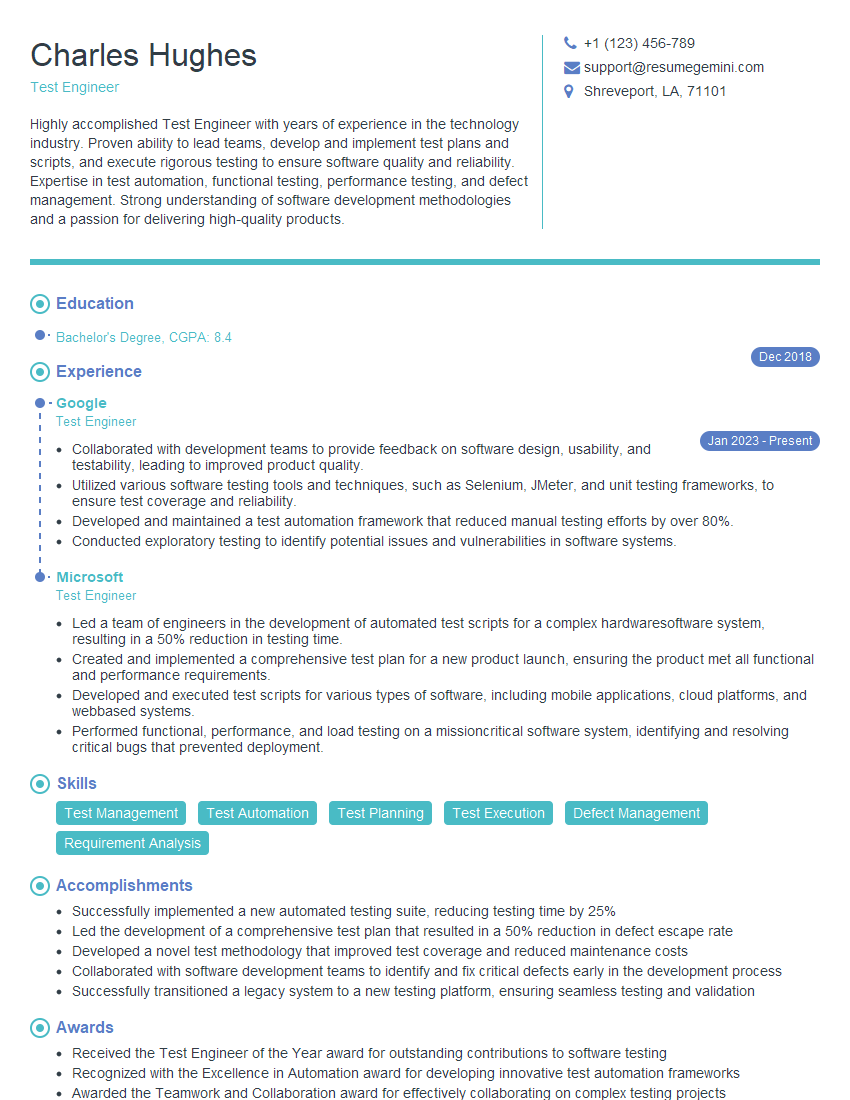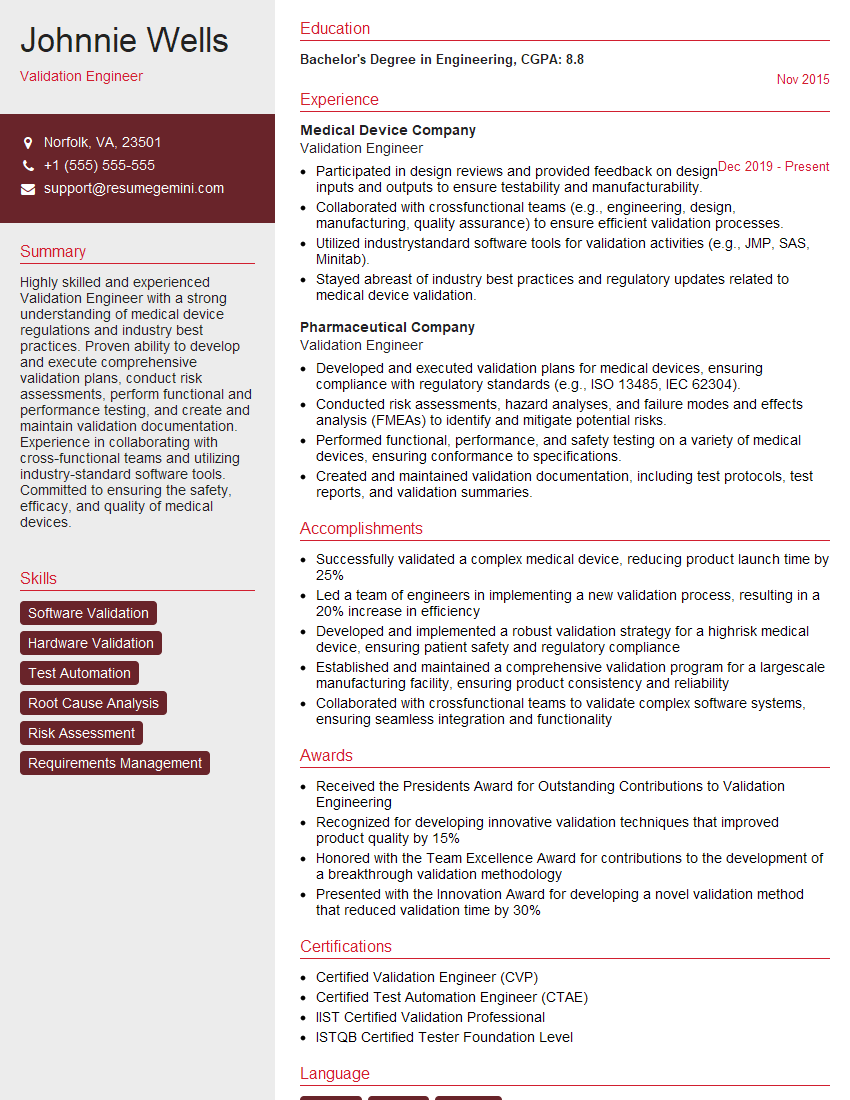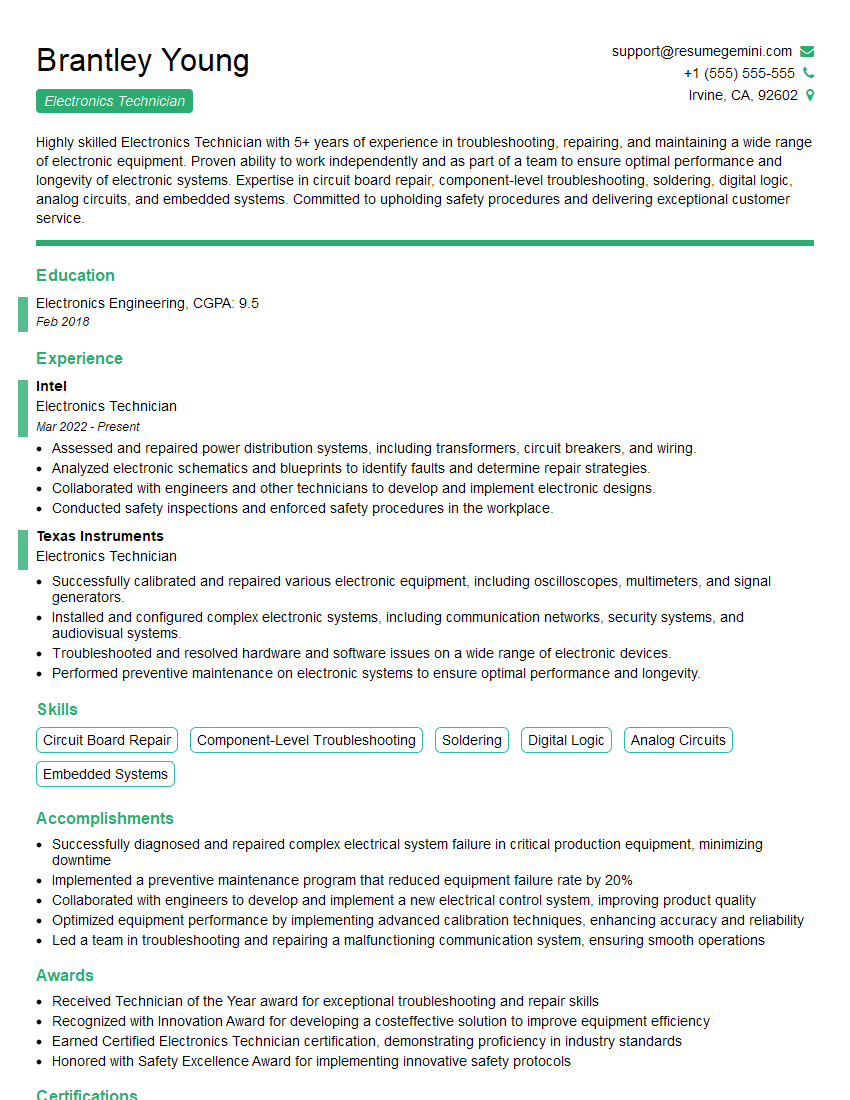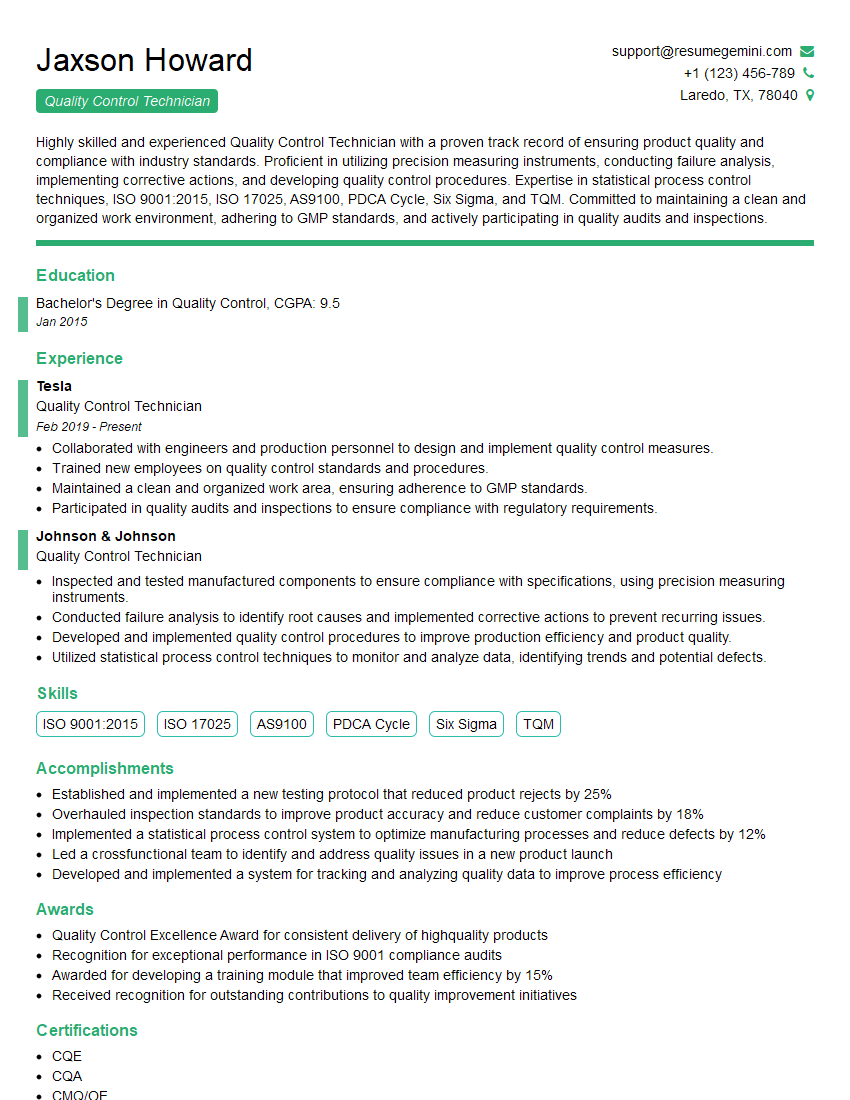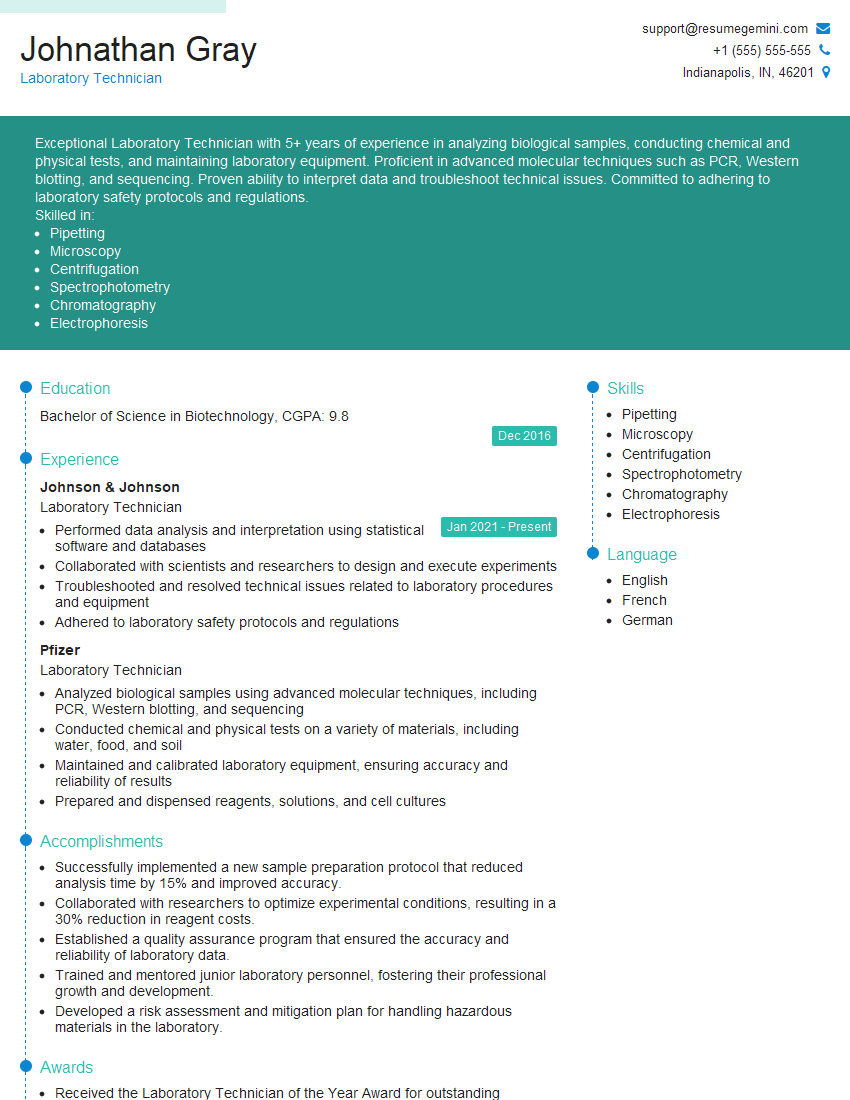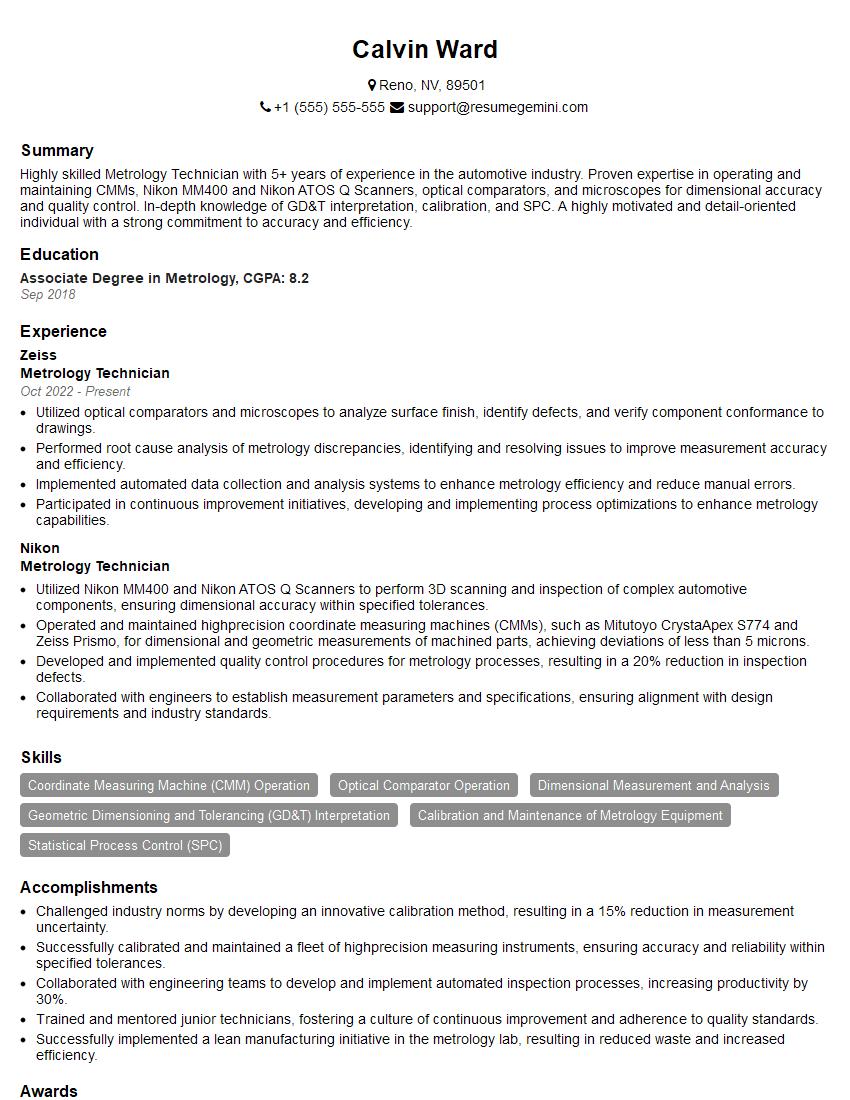The right preparation can turn an interview into an opportunity to showcase your expertise. This guide to Experience with calibration and maintenance of test equipment interview questions is your ultimate resource, providing key insights and tips to help you ace your responses and stand out as a top candidate.
Questions Asked in Experience with calibration and maintenance of test equipment Interview
Q 1. Explain the importance of equipment calibration.
Equipment calibration is crucial for ensuring the accuracy and reliability of test results. Think of it like this: if your kitchen scale is off by 10 grams, your baking will be consistently wrong. Similarly, inaccurate test equipment leads to flawed data, potentially resulting in incorrect decisions, wasted resources, and even safety hazards. Regular calibration guarantees that your equipment conforms to established standards, providing confidence in the validity of your measurements.
The importance extends to various sectors, from manufacturing and healthcare to aerospace and environmental monitoring. In manufacturing, calibrated equipment ensures products meet specifications; in healthcare, it ensures accurate diagnoses and treatments. Failing to calibrate can lead to product recalls, legal issues, and compromised patient safety. Essentially, calibration minimizes risk and maximizes the integrity of your operations.
Q 2. Describe the different types of calibration methods you are familiar with.
Calibration methods fall into two main categories: direct and indirect. Direct calibration involves comparing the equipment under test (UUT) to a known standard of higher accuracy, often a traceable standard from a national metrology institute. This is the gold standard, providing the most accurate results. For example, we might calibrate a digital multimeter (DMM) by comparing its voltage readings against a precision voltage source traceable to national standards.
Indirect calibration, on the other hand, involves calibrating the UUT using another calibrated instrument. While convenient, it introduces the potential for cumulative error, as the accuracy of the UUT depends on the accuracy of the reference instrument. A common example is calibrating a pressure gauge using a calibrated pressure transducer. The choice of method depends on the required accuracy and available resources.
Furthermore, calibration can be periodic (scheduled at fixed intervals), on-demand (triggered by specific events, such as equipment damage or significant use), or comparative (comparing the UUT’s performance to historical data).
Q 3. What are the common sources of error in test equipment?
Common sources of error in test equipment are multifaceted. Environmental factors play a huge role – temperature fluctuations, humidity, and even electromagnetic interference (EMI) can significantly affect readings. Aging components, such as worn-out capacitors or resistors, also contribute to drift and inaccuracy. Incorrect user operation, including improper setup or handling, is another major culprit.
- Environmental Factors: Temperature changes can affect resistance and capacitance values, leading to inaccurate measurements. Similarly, humidity can impact the performance of certain sensors.
- Component Degradation: Over time, internal components can degrade, causing the equipment to drift from its calibrated values. This is especially true for precision instruments.
- User Error: Incorrect settings, improper connections, or even a simple bump can affect the accuracy of the readings.
- Mechanical Wear: Moving parts in some equipment can wear down over time, leading to inconsistencies.
Internal calibration checks, regular maintenance, and proper usage procedures are essential to minimize these errors.
Q 4. How do you identify and troubleshoot faulty test equipment?
Identifying faulty equipment begins with observing any unusual readings or behavior. Inconsistencies, significant drift from previous calibrations, or error messages are key indicators. I would first visually inspect the equipment for any physical damage or loose connections. Then, I’d use known good standards to test the suspect equipment. If the readings are still inconsistent, I’d investigate further, potentially using diagnostic tools or consulting the equipment’s service manual.
Troubleshooting involves a systematic approach. I’d start with the simplest explanations, like checking power supplies and connections, before moving to more complex issues. If the problem persists, I might need to replace faulty components or contact the manufacturer for repair. Thorough documentation of the troubleshooting process is crucial for future reference and to aid in identifying potential systemic issues.
For example, if a digital oscilloscope shows erratic waveforms, I’d first check the probes, ensuring proper grounding and connections. Then, I might test it with a known signal generator. If the problem persists, internal components could be faulty, necessitating further investigation or professional repair.
Q 5. Explain your experience with different calibration standards (e.g., ISO 17025).
My experience encompasses working extensively with ISO 17025, the internationally recognized standard for testing and calibration laboratories. This standard outlines the requirements for competence, impartiality, and consistent operation of calibration labs. Understanding and adhering to ISO 17025 ensures that our calibration procedures are traceable, accurate, and reliable. It also helps establish credibility and confidence in the results we produce.
Beyond ISO 17025, I’ve worked with various national and industry-specific standards, tailoring our calibration procedures to meet the specific requirements of each. This understanding helps me navigate the complexities of different regulatory environments and ensures our calibration services meet the highest levels of quality and integrity.
Q 6. How do you ensure traceability in calibration procedures?
Traceability in calibration is paramount. It ensures that our measurements can be linked back to national or international standards, establishing a chain of custody for accuracy. We achieve this through a documented chain of calibrations, where each instrument’s accuracy is verified against a higher-level standard. This chain typically extends back to national metrology institutes (NMIs), which maintain the primary standards.
For example, a thermometer is calibrated against a secondary standard, which is itself calibrated against a primary standard maintained by a NMI. This documentation, meticulously maintained, forms the basis of traceability. This ensures that any discrepancy in a measurement can be traced back to its source, allowing for corrective actions and continuous improvement.
Q 7. Describe your experience with calibration software and documentation.
I am proficient in using various calibration software packages, including [mention specific software names if applicable, e.g., Fluke Calibration software, etc.]. These tools help automate calibration processes, manage calibration data, and generate reports. They are essential for maintaining a comprehensive and auditable record of all calibration activities.
My experience with calibration documentation involves creating and maintaining detailed calibration certificates and reports, adhering strictly to regulatory requirements. These documents include instrument details, calibration procedures followed, results obtained, uncertainties, and the traceability chain. Proper documentation is essential for compliance, quality assurance, and legal defensibility.
Q 8. What are the key safety precautions when working with test equipment?
Safety is paramount when working with test equipment. It’s not just about avoiding personal injury; it’s about protecting the equipment and ensuring accurate results. My approach begins with a thorough understanding of the equipment’s safety manual. This includes understanding voltage ratings, grounding requirements, and potential hazards like high voltage, RF radiation, or moving parts.
- Always power down equipment before making connections or adjustments. This prevents accidental shocks or damage from voltage surges.
- Use appropriate personal protective equipment (PPE), such as safety glasses, insulated gloves, and non-conductive footwear, depending on the equipment and voltage levels.
- Ensure proper grounding to prevent electrical shocks and stray currents from affecting measurements. This might involve using three-prong plugs and grounding straps.
- Never work alone, especially with high-voltage equipment. Having a colleague present provides an extra layer of safety and can be crucial in an emergency.
- Inspect equipment before use for any visible damage, loose connections, or frayed wires. Do not use damaged equipment.
For example, when working with high-voltage power supplies, I always use insulated gloves and double-check the output voltage before making any connections. A simple oversight could have serious consequences.
Q 9. How do you handle calibration discrepancies?
Calibration discrepancies are a critical issue that requires a systematic approach. When a discrepancy is detected – meaning the equipment’s readings deviate significantly from the accepted standard – I follow a well-defined protocol:
- Verify the measurement: Repeat the calibration process multiple times to eliminate any random errors. Check for proper instrument setup and environmental factors.
- Investigate the cause: Discrepancies can arise from several sources, including instrument drift, faulty components, environmental influences (temperature, humidity), or operator error. I carefully analyze all aspects of the measurement process to pinpoint the root cause. This might involve checking the calibration certificates of the reference standards used.
- Implement corrective actions: Depending on the cause, this might involve adjusting instrument settings, replacing faulty components, or recalibrating the equipment. Sometimes, specialized repair might be required. If it’s a systematic issue, I may need to review my calibration procedures for improvement.
- Document everything: Every step, from the initial discrepancy detection to the corrective actions taken and the results, is meticulously documented in the equipment’s calibration log. This forms an important audit trail.
- Recalibrate and verify: Once corrective actions are implemented, I recalibrate the instrument to verify that the discrepancy has been resolved. The whole process then requires a re-evaluation of uncertainty analysis.
For instance, if a multimeter showed consistent discrepancies in its voltage readings, I’d first check for a low battery, then examine the internal components for any signs of damage before considering a full recalibration.
Q 10. What is your experience with preventative maintenance of test equipment?
Preventative maintenance is crucial for ensuring the accuracy, reliability, and longevity of test equipment. My experience encompasses a wide range of maintenance tasks, tailored to the specific needs of the equipment.
- Regular cleaning: Dust and debris can accumulate, affecting accuracy and causing malfunctions. I regularly clean equipment with appropriate cleaning solutions, paying close attention to delicate components.
- Visual inspections: Routine inspections for loose connections, damaged cables, or physical wear and tear can help prevent major problems down the line. This helps identify issues early on before they impact accuracy.
- Functional checks: I periodically run functional tests to confirm the equipment is working correctly. This might involve checking specific functions, ranges, and accuracy. The testing criteria depends on the type of equipment.
- Calibration adherence: I maintain a strict calibration schedule, ensuring that the equipment is calibrated within its specified intervals. This maintains accuracy and ensures traceability.
- Proper storage: When not in use, I store equipment in a controlled environment to prevent damage from humidity, temperature fluctuations, or physical impact.
For example, I developed a monthly preventative maintenance schedule for our oscilloscopes, which includes visual inspection, cleaning, and a functional test using a calibrated signal generator. This proactive approach has significantly reduced downtime and the number of unexpected calibration failures.
Q 11. Describe your experience with different types of test equipment (e.g., oscilloscopes, multimeters).
Throughout my career, I’ve worked extensively with a variety of test equipment, including oscilloscopes, multimeters, power supplies, signal generators, spectrum analyzers, and network analyzers. My familiarity extends beyond basic operation to encompass the intricacies of calibration and maintenance for each type.
- Oscilloscopes: I am proficient in using oscilloscopes to measure voltage, frequency, and timing parameters. I understand various triggering modes and probe compensation techniques crucial for accurate measurements.
- Multimeters: I can utilize multimeters to measure voltage, current, resistance, and capacitance. I am experienced in selecting appropriate measurement ranges and understanding the limitations of each measurement type.
- Power Supplies: I’ve worked extensively with programmable and linear power supplies, adjusting output voltage and current precisely, and troubleshooting any output stability issues.
- Signal Generators: I understand how to set up and operate signal generators to produce various waveforms with specific frequencies and amplitudes, using them for calibrating other instruments.
Each instrument has its unique characteristics and potential failure modes. For instance, maintaining the probe calibration for an oscilloscope is critical for accurate high-frequency measurements. For multimeters, ensuring proper lead connections and avoiding overloads are paramount. My experience allows me to quickly diagnose and resolve issues across this diverse range of equipment.
Q 12. How do you maintain accurate calibration records?
Maintaining accurate calibration records is essential for demonstrating compliance, traceability, and ensuring the validity of test results. I use a combination of digital and paper-based systems to manage this effectively.
- Calibration Software: I often use dedicated calibration management software to track calibration schedules, record results, and generate reports. This helps maintain a central, easily accessible database of calibration information.
- Calibration Logbooks: For individual pieces of equipment, I maintain detailed logbooks recording each calibration event, including the date, the calibration results, any discrepancies found, and the corrective actions taken. The logbooks provide a detailed history of the instrument’s performance.
- Calibration Certificates: I ensure that all calibration certificates are properly filed and readily accessible. These certificates provide traceability to national or international standards.
- Barcodes and QR Codes: The utilization of barcodes or QR codes aids in accurate identification of the equipment during the calibration process, and can streamline data entry into digital systems.
This meticulous record-keeping ensures that we can easily trace the history of each instrument’s calibration, identify trends, and demonstrate compliance with any relevant regulations.
Q 13. Explain your understanding of uncertainty analysis in calibration.
Uncertainty analysis is crucial in calibration as it quantifies the uncertainty associated with a measurement result. It acknowledges that no measurement is perfectly precise; there’s always some degree of uncertainty. Understanding this uncertainty is vital for determining the reliability and validity of the calibration.
Uncertainty components stem from various sources:
- Instrument uncertainty: This is the uncertainty inherent in the measuring instrument itself, often specified in the instrument’s datasheet or calibration certificate.
- Reference standard uncertainty: The reference standards used for calibration also possess uncertainty, which contributes to the overall uncertainty of the measurement.
- Environmental uncertainty: Factors such as temperature, humidity, and pressure can affect measurements, contributing to the overall uncertainty.
- Operator uncertainty: The skill and experience of the operator can influence the measurement results, contributing to uncertainty.
I use statistical methods, often following guidelines such as those provided by ISO/IEC 17025, to combine these components to determine the overall measurement uncertainty. This provides a realistic estimate of the range within which the true value likely lies. The result is communicated as an expanded uncertainty typically at a 95% confidence level. This understanding is crucial in determining if an equipment is acceptable for use, based on the tolerance requirements of its applications.
Q 14. How do you manage calibration schedules and deadlines?
Managing calibration schedules and deadlines effectively requires a structured approach:
- Centralized Database: A database or spreadsheet is crucial to track calibration due dates for all equipment. The database should include asset ID, calibration date, due date, calibration history, and contact information for technicians.
- Automated Reminders: Automated reminder systems, either through software or email alerts, ensure that calibration activities are scheduled well in advance and don’t get overlooked.
- Prioritization: Critical equipment used in safety-critical applications or high-volume testing should be prioritized to ensure minimum downtime.
- Calibration Schedule Development: The schedule should be based on manufacturers’ recommendations, industry best practices, and the criticality of the equipment’s use.
- Regular Review and Updates: The calibration schedule must be regularly reviewed and updated to reflect changes in equipment usage, new equipment acquisitions, and any modifications to calibration procedures.
For instance, I utilize a software system that generates automated reminders for upcoming calibrations, ensuring that we never miss a deadline. This proactive management minimizes downtime and maximizes equipment availability.
Q 15. Describe your experience with calibration of specific types of equipment (e.g., pressure gauges, temperature sensors).
My experience with calibration encompasses a wide range of equipment, including pressure gauges, temperature sensors, and multimeters. Calibration isn’t just about getting a reading; it’s about ensuring the equipment provides accurate and reliable data. For pressure gauges, for instance, I’ve used both deadweight testers and electronic calibrators to compare the gauge’s readings against known, traceable standards. This involves applying various pressures, recording the gauge’s indication, and comparing it to the standard. Any deviation is documented and analyzed to determine if the gauge is within its acceptable tolerance. For temperature sensors, I’ve worked with dry-block calibrators and temperature baths, ensuring traceability to national standards. This often involves using multiple sensors for comparison and assessing linearity and accuracy across a sensor’s operating range. The process always includes meticulous record-keeping and adherence to documented procedures.
For example, I once calibrated a set of pressure gauges used in a high-pressure hydraulic system. One gauge showed a consistent 5% deviation across its range. After confirming the error wasn’t due to a faulty calibrator, I identified a small leak in the gauge’s internal mechanism. This highlights the importance of not just calibration but also proper maintenance and inspection.
Career Expert Tips:
- Ace those interviews! Prepare effectively by reviewing the Top 50 Most Common Interview Questions on ResumeGemini.
- Navigate your job search with confidence! Explore a wide range of Career Tips on ResumeGemini. Learn about common challenges and recommendations to overcome them.
- Craft the perfect resume! Master the Art of Resume Writing with ResumeGemini’s guide. Showcase your unique qualifications and achievements effectively.
- Don’t miss out on holiday savings! Build your dream resume with ResumeGemini’s ATS optimized templates.
Q 16. What is your experience with Root Cause Analysis (RCA) for equipment failures?
Root Cause Analysis (RCA) is crucial for preventing equipment failures. My approach typically follows a structured methodology, often employing the 5 Whys technique. This involves repeatedly asking ‘why’ to uncover the underlying causes of a failure. I also utilize fault tree analysis, which graphically depicts the potential causes of a failure, enabling a systematic investigation. Furthermore, I always review maintenance logs, calibration records, and operating procedures to identify trends or patterns that may have contributed to the failure. For instance, a recurring issue with a particular type of sensor might point to a flaw in its design or a problem with the supply chain.
In one instance, a critical piece of testing equipment failed repeatedly. Using RCA, we initially identified a blown fuse. The ‘5 Whys’ eventually revealed the root cause: surge protection was inadequate, leading to voltage spikes. This led to upgrades in our electrical infrastructure and preventative measures to protect the equipment. Thorough RCA isn’t just about fixing the immediate problem; it’s about preventing future recurrences.
Q 17. How do you ensure the accuracy of calibration results?
Accuracy in calibration results hinges on several factors. Firstly, using traceable standards is paramount. This ensures that the calibrations are linked back to national or international standards, providing a verifiable chain of custody. Secondly, maintaining and regularly calibrating the calibration equipment itself is essential. A poorly maintained calibrator will produce inaccurate results. Thirdly, environmental factors, such as temperature and humidity, can significantly affect measurement accuracy; controlled environments are therefore necessary. Finally, meticulous documentation is key. All calibration steps, readings, and adjustments must be recorded accurately and legibly.
To ensure accuracy, I always use multiple calibrated standards where possible to cross-check readings. I also regularly review the uncertainty of measurement for each piece of equipment, as well as the uncertainty of the standards themselves, and propagate these uncertainties through calculations. This allows me to understand and quantify the overall uncertainty of the calibration.
Q 18. Describe a time when you had to troubleshoot a complex equipment issue.
I once faced a challenging situation with a complex automated testing system that unexpectedly stopped working mid-test. Initial troubleshooting pointed to a sensor failure, but replacing the sensor didn’t resolve the issue. The system was critical for production, and downtime was costly. I systematically checked all aspects: power supply, communication lines, software, and mechanical components. I used diagnostic tools to isolate the problem, eventually discovering a loose connection within a relay board inside the system. This seemingly minor issue resulted in a complete system failure. The solution was simple once the problem was identified; but the key was methodical troubleshooting.
This experience reinforced the importance of a structured approach, starting with the most obvious causes and working through potential failure points methodically. Careful documentation and accurate records also aided in the diagnostics and assisted in resolving the problem efficiently.
Q 19. How do you stay up-to-date with the latest calibration techniques and standards?
Staying current with calibration techniques and standards requires a multifaceted approach. I regularly attend industry conferences and workshops. I subscribe to relevant professional journals and online resources, such as publications from NIST (National Institute of Standards and Technology) and other national metrology institutes. I also participate in professional organizations related to calibration and measurement. This allows for networking and access to the latest advancements. Furthermore, I make sure to review and stay updated with any changes to relevant standards such as ISO/IEC 17025, which governs the competence of testing and calibration laboratories.
Continuous learning is vital in this field, as technologies and standards evolve rapidly. Staying updated not only improves my performance but also ensures that the company maintains compliance with regulations and best practices.
Q 20. What are the different types of calibration certificates and their significance?
Calibration certificates vary, but the most common are UKAS (United Kingdom Accreditation Service) accredited certificates, ISO 17025 accredited certificates, and in-house certificates. A UKAS or ISO 17025 accredited certificate indicates that the calibration was performed by a laboratory accredited to a recognized international standard, ensuring high quality and traceability. These certificates usually have a detailed description of the equipment, the calibration procedure, measurement uncertainty and more. In-house certificates are generated when the calibration is performed internally, but these are usually only considered valid within the company itself and do not provide the same degree of traceability as an accredited certificate.
The significance lies in the level of confidence and traceability they offer. An accredited certificate provides assurance that the calibration was performed to a high standard, making it suitable for regulatory compliance, particularly in industries with stringent quality requirements. The choice of certificate depends on the criticality of the equipment and its intended use.
Q 21. Explain your experience with performing environmental testing (temperature, humidity etc.)
My experience with environmental testing, specifically temperature and humidity, includes both performing and overseeing tests. I’ve worked with environmental chambers to simulate various climatic conditions, and understand the importance of accurate control and monitoring during such tests. This involves calibrating the chamber itself, as its temperature and humidity readings need to be accurate to ensure reliable test results. I have experience with various types of environmental test equipment including walk-in chambers, temperature and humidity data loggers and more. I’m familiar with various international standards and testing procedures for these environments like IEC 60068 and other industry-specific regulations.
For example, I was involved in environmental testing of electronic components, which requires maintaining precise temperature and humidity levels to understand the component’s performance under different conditions. These tests are critical for ensuring product reliability and compliance with industry standards. This involves careful monitoring of the equipment, data logging, and statistical analysis of the collected data.
Q 22. Describe the process of verifying the accuracy of a calibration standard.
Verifying the accuracy of a calibration standard involves comparing it to a higher-order standard, ultimately tracing back to national or international standards. Think of it like a chain of accuracy; each link must be meticulously checked.
The process typically involves:
- Selecting the appropriate higher-order standard: This standard must have a known and traceable uncertainty significantly lower than the standard being verified.
- Performing the comparison: This might involve direct comparison using a suitable measurement instrument or indirect comparison through a series of measurements and calculations. For example, a calibrated thermometer might be used to verify the accuracy of a less precise thermometer.
- Analyzing the results: The difference between the readings of the two standards, along with the uncertainties associated with each, is used to determine if the standard under verification meets its specified tolerances. Statistical methods are frequently employed to assess the accuracy.
- Documentation: All procedures, measurements, and calculations must be meticulously documented, including any deviations from the standard operating procedure (SOP). This documentation forms a crucial part of the calibration record.
For instance, if we’re verifying a 100-ohm resistor, we’d compare it against a 100-ohm resistor with a much smaller uncertainty, possibly a NIST-traceable standard. Any discrepancies exceeding predefined tolerances would indicate the need for adjustment or replacement of the standard.
Q 23. How do you handle equipment repairs and when would you escalate to a higher level?
Equipment repairs are handled systematically. First, a thorough assessment is made to identify the cause of the malfunction. This often involves checking connections, power supply, and simple troubleshooting steps documented in the equipment’s manual.
If the issue is minor and I possess the necessary skills and parts, I’ll perform the repair and document the procedure, including the parts replaced and the tests performed to ensure functionality. For example, replacing a blown fuse or cleaning a dirty optical sensor are common minor repairs.
However, if the problem is complex—for instance, a critical internal component failure, requiring specialized tools or knowledge beyond my expertise, or if the repair requires specialized calibration post-repair—I escalate the issue to a higher level. This might involve contacting a qualified technician, the equipment manufacturer, or the calibration laboratory, depending on the equipment and the organization’s maintenance structure.
Escalation is always documented, including the nature of the problem, attempts made to resolve it, and the communication with the next level of support.
Q 24. Explain your understanding of GMP or similar regulatory guidelines related to equipment calibration.
Good Manufacturing Practices (GMP) and similar regulatory guidelines, such as ISO 9001 and ISO 17025, emphasize the critical role of accurate and reliable equipment in maintaining product quality and safety. These regulations mandate rigorous calibration and maintenance procedures to ensure that equipment functions within specified tolerances.
GMP guidelines dictate that all equipment used in manufacturing or testing must be calibrated regularly according to a defined schedule. This schedule is based on the criticality of the equipment, its frequency of use, and the potential impact of inaccuracies on product quality. Calibration records must be meticulously maintained, demonstrating compliance with regulatory requirements.
Failure to comply with these guidelines can lead to significant consequences, including product recalls, regulatory fines, and reputational damage. For instance, in pharmaceutical manufacturing, inaccurate weighing equipment could result in incorrect dosages, posing serious risks to patient safety. Therefore, adherence to calibration procedures is paramount.
Q 25. What is your experience with automated calibration systems?
I have extensive experience with automated calibration systems, which significantly improve efficiency and traceability compared to manual methods. These systems typically manage calibration schedules, automate data collection, and generate comprehensive reports.
My experience includes working with systems that use barcode scanners for asset tracking, automated measurement devices that interface directly with the calibration system, and software that manages calibration certificates and reports. These systems help eliminate human error, ensure timely calibration, and provide a robust audit trail.
One example is a system I used which managed the calibration of over 500 instruments across multiple labs. The software automatically flagged instruments nearing their due dates, generated work orders for technicians, and compiled detailed calibration reports that were readily accessible for audits. This system greatly simplified the calibration process and improved overall efficiency.
Q 26. Describe your experience with different types of calibration instruments.
My experience encompasses a wide range of calibration instruments and techniques, including:
- Electrical: Multi-meters, oscilloscopes, power supplies, temperature sensors (thermocouples, RTDs), and resistance decade boxes.
- Mechanical: Micrometers, calipers, dial indicators, and force gauges.
- Thermometric: Temperature calibrators, dry block calibrators, and infrared thermometers.
- Dimensional: Optical comparators and coordinate measuring machines (CMMs).
The specific calibration methods vary depending on the type of instrument. For example, calibrating a multi-meter might involve comparing its readings against known voltage, current, and resistance standards, while calibrating a force gauge would involve comparing it against a known force standard using a deadweight tester.
My experience also includes understanding the intricacies of various calibration standards and traceability, ensuring the highest level of accuracy.
Q 27. How do you prioritize calibration tasks?
Prioritizing calibration tasks involves a multi-faceted approach, considering several crucial factors:
- Criticality: Equipment critical to safety, product quality, or regulatory compliance takes precedence. For example, a scale used for dispensing pharmaceuticals needs calibration more frequently than a non-critical instrument.
- Frequency of use: Instruments used frequently are more likely to drift out of calibration, requiring more frequent checks. High-use equipment gets prioritized.
- Due dates: Instruments nearing their calibration due dates must be addressed promptly to avoid non-compliance. This often forms the basis of automated scheduling systems.
- Risk assessment: Considering potential consequences of equipment failure guides prioritization. Failure of critical instruments leads to higher-priority calibration.
We use a combination of scheduled calibrations and condition-based maintenance—if an instrument shows signs of drift or malfunction, it’s moved up in priority. This approach ensures we address the highest risk items first while maintaining an effective calibration schedule.
Q 28. What are your strengths and weaknesses in relation to calibration and maintenance?
My strengths lie in my meticulous attention to detail, my systematic approach to problem-solving, and my ability to effectively manage complex calibration schedules. I’m adept at troubleshooting equipment issues and possess a strong understanding of various calibration techniques and standards.
One area for development is expanding my knowledge of the latest automated calibration software and systems. While I’m proficient with existing systems, staying current with the latest technologies and software is essential in this rapidly evolving field. I’m actively seeking opportunities to enhance my skills in this area through training and hands-on experience.
Key Topics to Learn for Experience with Calibration and Maintenance of Test Equipment Interview
- Calibration Standards and Procedures: Understanding different calibration standards (e.g., ISO 17025), traceability, and the proper documentation procedures for maintaining calibration records. This includes understanding the importance of accuracy and uncertainty in measurements.
- Common Test Equipment: Familiarize yourself with the operation, maintenance, and troubleshooting of various types of test equipment relevant to your field, such as oscilloscopes, multimeters, function generators, power supplies, and spectrum analyzers. Be prepared to discuss specific models you’ve worked with.
- Preventive Maintenance and Troubleshooting: Understand the importance of routine maintenance tasks to prevent equipment failure. Be ready to discuss techniques for identifying and resolving common issues, including understanding error messages and diagnostic procedures. This also includes understanding safety protocols when working with electrical equipment.
- Calibration Techniques: Explain different calibration methods, including using calibration standards, performing adjustments, and documenting results. Be ready to discuss your experience with various calibration techniques, and the tools and software used in the process.
- Data Analysis and Reporting: Discuss your experience analyzing calibration data, identifying trends, and generating reports. This includes understanding the importance of accurate data recording and the use of statistical analysis techniques where applicable.
- Safety Procedures and Regulations: Demonstrate a thorough understanding of all relevant safety procedures and regulations related to handling and maintaining test equipment, ensuring compliance with workplace standards and minimizing risks.
- Software and Calibration Systems: Familiarity with software used for calibration management, data acquisition, and reporting. Be prepared to discuss any specific systems you’ve utilized.
Next Steps
Mastering experience with calibration and maintenance of test equipment is crucial for career advancement in many technical fields, demonstrating your attention to detail, problem-solving abilities, and commitment to accuracy. A strong resume is your first step to showcasing these skills. To significantly improve your job prospects, create an ATS-friendly resume that highlights your relevant experience and skills effectively. ResumeGemini can be a trusted resource for building a professional and impactful resume tailored to your experience. Examples of resumes tailored to experience with calibration and maintenance of test equipment are available to help guide you.
Explore more articles
Users Rating of Our Blogs
Share Your Experience
We value your feedback! Please rate our content and share your thoughts (optional).
What Readers Say About Our Blog
Hello,
We found issues with your domain’s email setup that may be sending your messages to spam or blocking them completely. InboxShield Mini shows you how to fix it in minutes — no tech skills required.
Scan your domain now for details: https://inboxshield-mini.com/
— Adam @ InboxShield Mini
Reply STOP to unsubscribe
Hi, are you owner of interviewgemini.com? What if I told you I could help you find extra time in your schedule, reconnect with leads you didn’t even realize you missed, and bring in more “I want to work with you” conversations, without increasing your ad spend or hiring a full-time employee?
All with a flexible, budget-friendly service that could easily pay for itself. Sounds good?
Would it be nice to jump on a quick 10-minute call so I can show you exactly how we make this work?
Best,
Hapei
Marketing Director
Hey, I know you’re the owner of interviewgemini.com. I’ll be quick.
Fundraising for your business is tough and time-consuming. We make it easier by guaranteeing two private investor meetings each month, for six months. No demos, no pitch events – just direct introductions to active investors matched to your startup.
If youR17;re raising, this could help you build real momentum. Want me to send more info?
Hi, I represent an SEO company that specialises in getting you AI citations and higher rankings on Google. I’d like to offer you a 100% free SEO audit for your website. Would you be interested?
Hi, I represent an SEO company that specialises in getting you AI citations and higher rankings on Google. I’d like to offer you a 100% free SEO audit for your website. Would you be interested?
good

